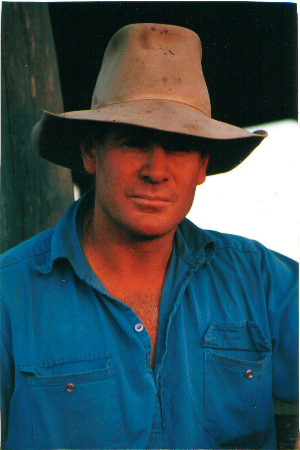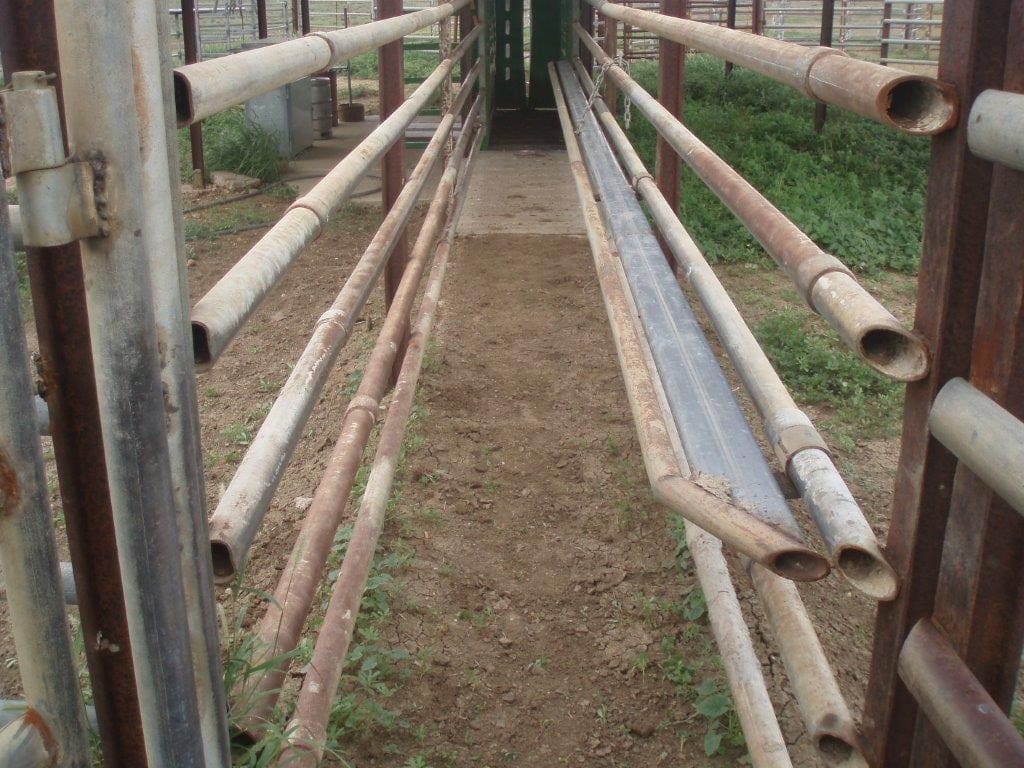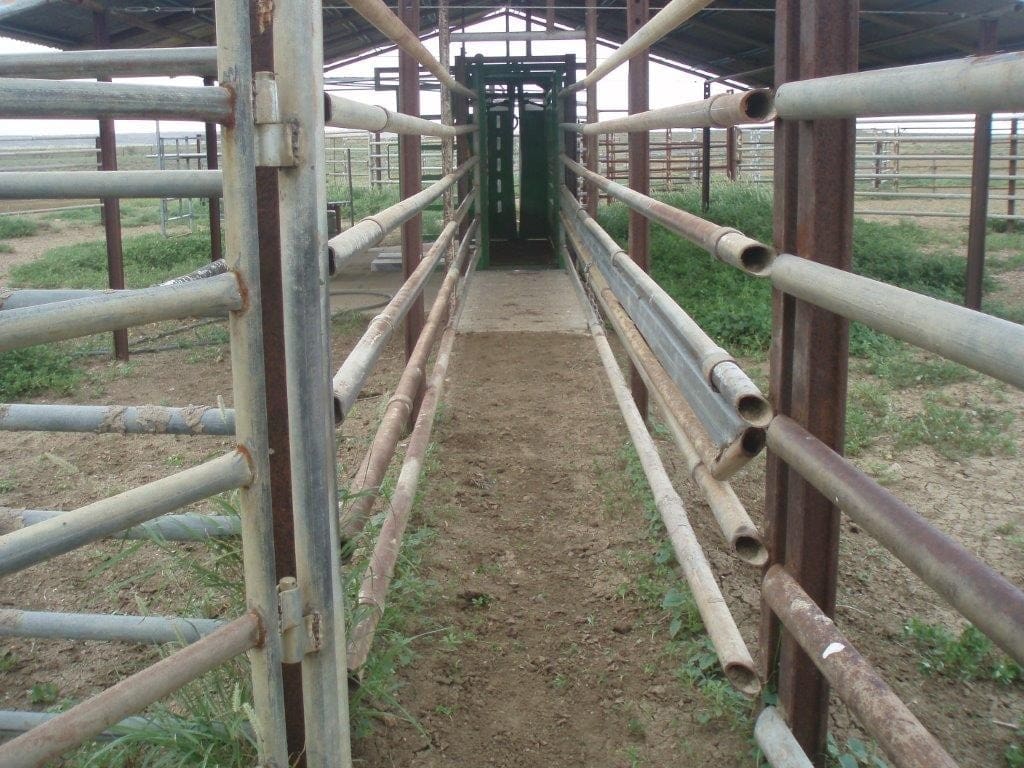When we asked if readers knew of an effective way to stop weaner cattle turning around in races built for adult cattle, Jim Lindsay reached out with a practical solution that has all but eliminated the problem on his North Queensland cattle properties.
Jim’s answer involves hanging a long, horizontal rail, approximately 20cm wide, at the pin-bone height of weaner cattle on the inside of a race.
The hinged rail can be swung up and suspended by a chain at right-angles to the wall to effectively narrow the width of the race when weaners are being handled (see picture below).
The rail reduces the internal width of the race from about 70cm wide to 50cm.
When weaners are not being used the hanging rail can be dropped so it is flush with the inside wall and out of the way when adult cattle are being handled (as shown below).
Practical experience
Some background here is important. It would be an immense understatement to say Jim knows a lot about handling cattle. He has been an instructor at Low Stress Stock Handling schools and KLR cattle marketing courses around Australia for more than 20 years.
Jim and his family also run a cattle trading operation, through which they buy and sell large numbers of cattle, including many weaners, for their Hughenden properties Kentle and Landsborough each year.
Like many other producers, the Lindsays’ operation is a family-sized business run by family members with little help from outside staff.
Handling thousands of weaners of his own each year means Jim is well versed in the frustrations that go with having to regularly walk back along a race to turn weaner cattle around and moving forward. Not only does it waste time, he says, it is not good for the cattle either.
So when Jim began upgrading his yards on Kentle last year, finding a solution to the weaner handling problem was one of his main priorities.
‘Leg freedom is crucial’
In his role as a livestock industry educator Jim has seen many cattle handled through many different yards and races.
One certain principle he says his experience has taught him is that when cattle are moving to a new place, they must be able to lower their head and smell the ground in order to feel comfortable and safe.
‘Cattle must be able to lower their head and smell the ground to feel comfortable’
That means they must always have enough space to widen the stance of their front legs so they can drop their head to smell as they enter unfamiliar environments.
“When they are coming up a race and feeling a bit vulnerable, they want to be able to smell so they like to have their feet apart,” Jim said.
“If the race doesn’t let that animal put its feet where it wants to put them for stability and sureness, they can begin to get agitated and they back up and turn around because they can’t get to a spot where they feel okay.”
Jim came up with the idea of using a narrow rail to reduce the effective width of the race at the shoulder height of weaners, while simultaneously allowing them to widen their feet and smell the ground in front of them.
The new rail was an instant success when he installed it last year.
“When the weaner goes to turn they feel the rail against their pin bone and shoulder,” he explained.
“When they feel they can’t turn then they don’t keep trying.
“It is when they feel they have enough room to turn then they never stop trying.
“You can see them standing in there with their legs quite spread, but they can’t turn because the minute they go to turn the rail just tucks them in.
“It is a funny thing, you’d be amazed how many less animals try to turn around in that system than a wedge shaped one where they cannot spread their feet.”
Low-cost time saver
What amounts to little more than two lengths of steel has saved hours of wasted time on Jim’s properties.
“We can put literally thousands of smaller weaners, down to as low as 170kg, through there, and out of 1000 you might get half a dozen turn around,” Jim said.
“It is pretty incredible.
‘this would have halved the time it takes us to process weaners’
“When the race is wide, they turn around all the time because they feel they can, and they are trying to get away from activity up the front.
“This rail would have halved the time it takes us to process weaners through the race, every time we open the head bail we have an animal ready to walk in.”
‘Educational’ benefits
The low-cost innovation not only saves time and money but also helps to educate young cattle for life.
Australian producers now tend to handle cattle more often because of the modern requirements of weighing, animal husbandry and pre-sale drafting.
Teaching young cattle to move through yards in a calm, low stress manner from an early age is more important as a result.
“We’re putting animals through these handling systems far more regularly these days, and what we have found is that if you put them through and they don’t turn around they don’t learn bad habits.
“We have found the cattle don’t get worse, they get better.
“We have got to work out ways to make animals feel more cooperative, not less cooperative, and little things like this can make a huge difference.”
Click on images below to view in larger size




I included rails like these in a yard I built on “Caldervale” in 2002 when Rob Cameron was managing. They worked very well. If you have a curved race you need to have individual rails for each panel.- Peter Cause – http://www.causecontracting.com.au
Great idea I’ve been thinking of doing a similar thing in my race but the race is curved. Do you have any pictures of this in a curved race?
The standard race does provide enough room, however you will find one animal will follow the other, and so on through the race. If you don’t pack the race too tight, Yes, some adult cattle will get there head down and smell, but in hind site you need there head up, and tight enough too work on animals as required.
Full names required in future please Brian, as per reference on our comment entry box. Editor.
Canobie station Julia creek AA company has this same thing when I was there in 2010.
Does the standard race for adult cattle, allow enough room for adult cattle to spread their front legs enough to lower their heads to smell.?
I was just wondering,(I am not a cattle man)
would you mind to forward Jim Lindsay’s email address, I am developing a cattle sheep and goat equipment manual for livestock export. I have a client in Adiyaman East Turkey that would like that solution. Thanks
Why didn’t I think of that? Like all great ideas, it’s so SIMPLE.